Let’s make the most of Bike to School Week 2020!
Bike to School Week is coming up on May 4-8 with Bike to School Day on Wednesday, May 6. We’ve celebrated this day in rain and snow, but our current circumstances in 2020 are certainly the most unique that we’ve seen.
Fortunately, even during social distancing, we’re able to get out on our bikes while keeping a safe space from other riders and protecting ourselves and others with a mask or other face covering. Although students aren’t currently attending school in person, now is a fantastic time for families to take advantage of lighter traffic and a less pressing schedule to practice a route to school with their children, whether that’s on wheels or foot. We hope you’ll use this time to model and teach safe practices along the way and discuss the many benefits of biking, walking or rolling (on a scooter, skateboard or in a wheelchair) as you’re enjoying them. Bicycling is also a great way now and during the school year for kids to get their recommended 60 minutes of moderate physical activity each day. Below we share some ideas for your next ride, walk or roll to school or around your neighborhood, and jump down to our traffic safety tips if you need to review how you and your child can keep yourselves and others safe while navigating sidewalks and streets.
Remember, if riding a bike isn’t the best option considering your child’s age or your neighborhood environment, walking or rolling are great alternatives! And for those who live too far from school, you can park off-campus and travel the rest of the way on wheels or foot to still give children a chance for exercise and to practice traffic safety.
Jump to:
Celebrate the benefits
Talk on your trip about all of the wonderful benefits of bicycling, walking and rolling, including how it’s good for the earth and air, our muscles and our brain. It’s also an opportunity to connect with friends, family and the broader community. With older kids, you can discuss how traveling without a car costs less money and reduces traffic, and fewer cars can mean safer streets. Here are a few conversation starters:
- What signs of nature do you hear or see?
- How would your experience be different during another season?
- How do your body and brain feel halfway through or after finishing your ride, walk or roll?
- How is biking, walking or rolling with family different than sitting in a car together?
- What people do you encounter outside on your route? How many drivers did you see? How do these numbers compare to more normal times?
- What things about your community hadn’t you noticed before (landmarks, buildings, street names, etc.)? Do you know the story behind these places?
The frame game
The “frame game” is one of our favorite activities for kids to think about the physical environment along their wheeling or walking route and their behaviors in response. All this activity requires is a pair of rectangular paper frames, one decorated with smiley faces and one with frowny faces.
On your practice route to school, ask your child to hold up their “smiley frame” around safe places or situations and use their “frowny frame” to identify situations that could present a danger where they should be extra cautious. With your smiley frame, you could highlight a painted crosswalk, textured ramp or speed hump, while a frowny frame could highlight a crumbling sidewalk, major intersection crossing or car parked in the bike lane.
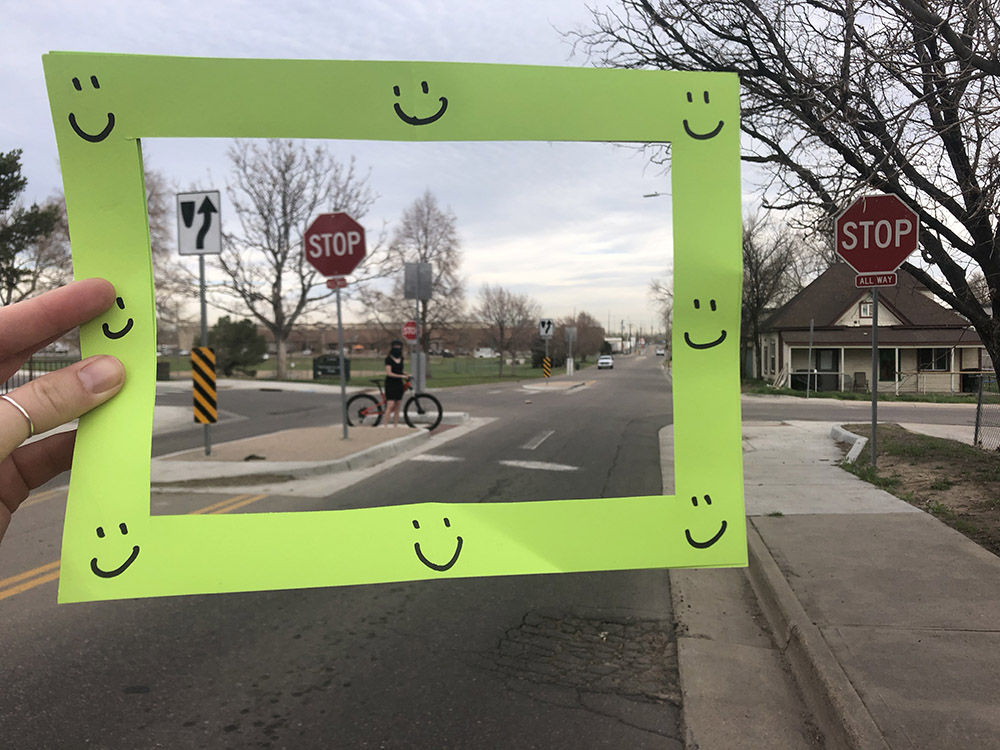
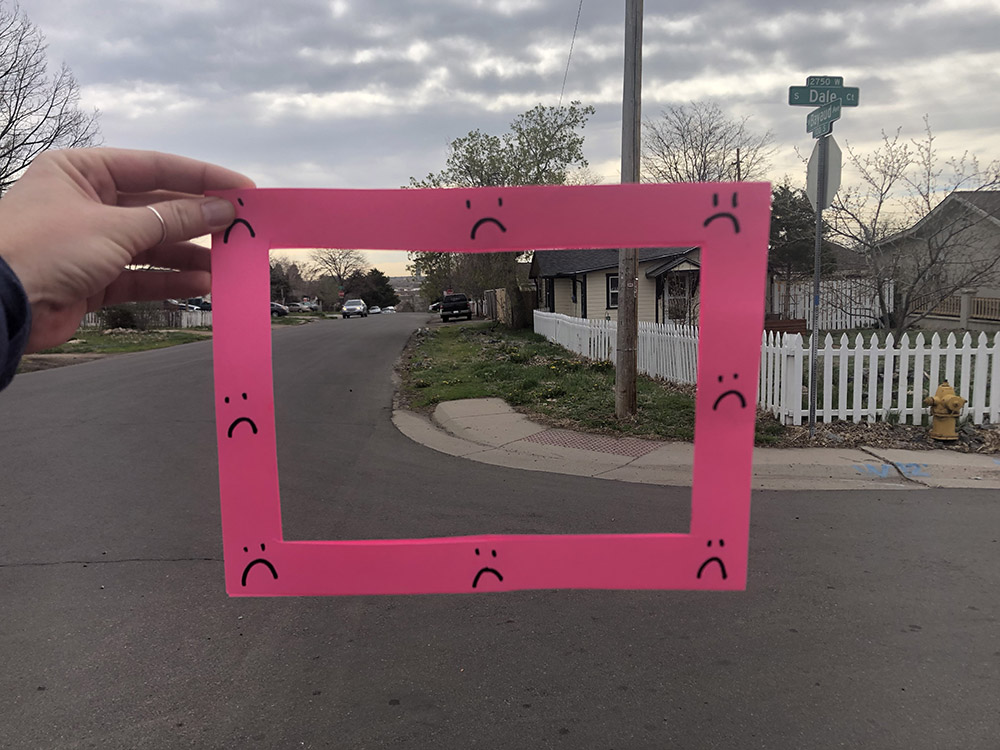
Next, spend some time discussing what they framed and how it increases safety or what they might need to do in response to less safe situations. Take this activity a step further by snapping a photo of your child framing the safe spots and areas for improvement and send these photos to your city staff or council. Explain your enthusiasm about biking, walking and rolling, thank them for the safe features and ask for improvements that will help you and others outside of cars stay safe.
Take some extra time when you arrive at school to observe what the campus (the street, intersections and parking lot) looks and sounds like. Pretty different without the typical drop-off and pick-up rush, huh? With these less crowded conditions, explore the safest path to navigate from within a block of school to the school’s doorstep, including the best place to cross the street. If your school has a bike rack, have your child practice locking their bike, securing the frame and at least the front wheel.
Traffic safety tips for kids (and anyone!)
As we discuss traffic safety with children, we want them to build confidence in getting around on sidewalks and streets while also understanding that, though they follow the rules of the road, they may need to look out for others who do not. The physical environment may also be less than ideal in some places where children will need to step up their safety skills.
Below are some important traffic safety tips for adults to review and model with their children that will help them and others stay safe while traveling to school or around their neighborhoods. Children on bikes should first have an understanding of pedestrian safety practices since many of them apply to both children walking and wheeling, and children under the age of 10 are encouraged to bike (with caution) on the sidewalk. A list of bike-specific safety tips follows those immediately below.
Before the trip
Plan and practice the route
A good place to start is with the walking route generated by Google Maps. Scout out the route to ensure it’s the best one and consider factors like car traffic, speeds, other people, sidewalk condition or ramps if you or your child need this access. If the route doesn’t follow off-street paths, you may want to first explore the route by car. Next, practice it on wheels or foot at a time of day when students would typically be traveling to or from school.
Teach your child what to do in an emergency
Help them memorize your phone number and identify safe places along the route in case they need to ask for help.
Travel with others
Younger children should travel with someone taller or in a group to be more visible. And according to the National Highway Transportation Safety Administration and American Academy of Pediatrics, children should be accompanied by an adult or young adult until the age of 10. At that point, most children can accurately judge speed and distance and are developmentally ready to walk alone or bike on the street after careful modeling and coaching from an adult.
Wear the right clothes and gear
When it’s cold or there’s possible rain, dress to stay comfortable and protected from the elements. Some families might choose to dress their child in a bright shirt or vest to increase visibility. When it’s dark on the way to school during winter months, children can wear reflective gear.
Leave with plenty of time
It typically takes children about 20 minutes to walk a mile and bicycling pace will vary with the route and comfort level of each rider. Practicing your route will give your family a better idea of how much time you’ll need to avoid a rush.
During the trip
Use sidewalks or paths
The safest place for people to walk is on the sidewalk where drivers expect to see them. If there are no sidewalks, walk as far to the left as possible, facing oncoming traffic so you can see drivers traveling toward you. Unlike pedestrians, bicyclists riding in the street should travel in the same direction as traffic. See section “Transitioning to the street” for more information on riding with your child on the road.
Walk or roll at a safe speed to stay alert
Running or riding too fast will keep you from seeing or hearing potential obstacles. Travel at a safe speed so you can react to these obstacles and to be respectful of others on your route. On paths and trails, the speed limit is typically 15 mph for people on bikes.
Make your own decisions
Especially when traveling with friends, each child should decide for themselves when it is safe to enter or cross the street.
Stop at any “edges”
Stop at edges, curbs, driveways or anywhere the sidewalk ends or intersects with another path. Look and listen before continuing on. On a bike, be especially careful at edges as drivers, especially those turning, may not be expecting bicyclists traveling more quickly on the sidewalk.
Cross safely
Identify the safest places to cross like corners, painted crosswalks, traffic signals and intersections. Listen and look left, right, left (and behind at four-way intersections) before crossing and continue checking for drivers as you cross.
Follow all signs and signals
Discuss what traffic signs and signals mean and how we follow them. These might include painted markings like a crosswalk, the colors of a traffic light or pedestrian signals. (Remember, “green” and “walk” don’t always mean it’s safe to go. Always be sure to look and listen first!)
Stay visible to drivers
Make sure you can see drivers which can also help you be visible to them. Try to make eye contact or wait if you aren’t sure whether they see you.
Stay extra alert in high-traffic areas
Children are hard to see among vehicles, particularly large cars, trucks and buses, so avoid traveling through parking lots and be extra careful around parked cars or when crossing driveways. Drivers should be looking for people outside of cars, but move slowly and look and listen for signs that they are pulling in or out like the motor, white or red rear lights or exhaust.
Check out the National Center for Safe Routes to School’s Teaching Children to Walk Safely for a full guide on how to teach your child pedestrian safety. And don’t forget to have fun; an active trip to school is a social adventure! Don’t forget to have fun in all the unique ways we can outside, on wheels or foot and with others.
Additional information for families on bikes and scooters
Now that we’ve covered the traffic safety basics for all kids, it’s time to talk about safe biking.
Keep in mind that if you or your child ever feel unsafe, dismounting and walking your bike is always an option!
Clothing and gear
- Wear a helmet, avoid loose clothing and tie shoelaces.
- Check your helmet and bike with the Two-Finger Test and ABC Quick Check.
- For extra visibility, you can wear a bright shirt, reflective gear or attach a flag to the rear of a bike.
- Travel with a lock and make sure your child’s school has sufficient and secure bike parking or scooter storage.
Communication
- Slow down for or yield to people walking or rolling. Pass others on the left and ring a bell or kindly announce, “On your left!” You can also communicate stopping to others with “Stopping!
- Once they are comfortable with balance and steering, children can start practicing hand signals before turning, which are required for adult riders in Colorado.
- People on bikes in Colorado are required to ride with at least a white light, a rear red reflector (we encourage a rear red light) and side reflectors after dusk or when visibility is poor.
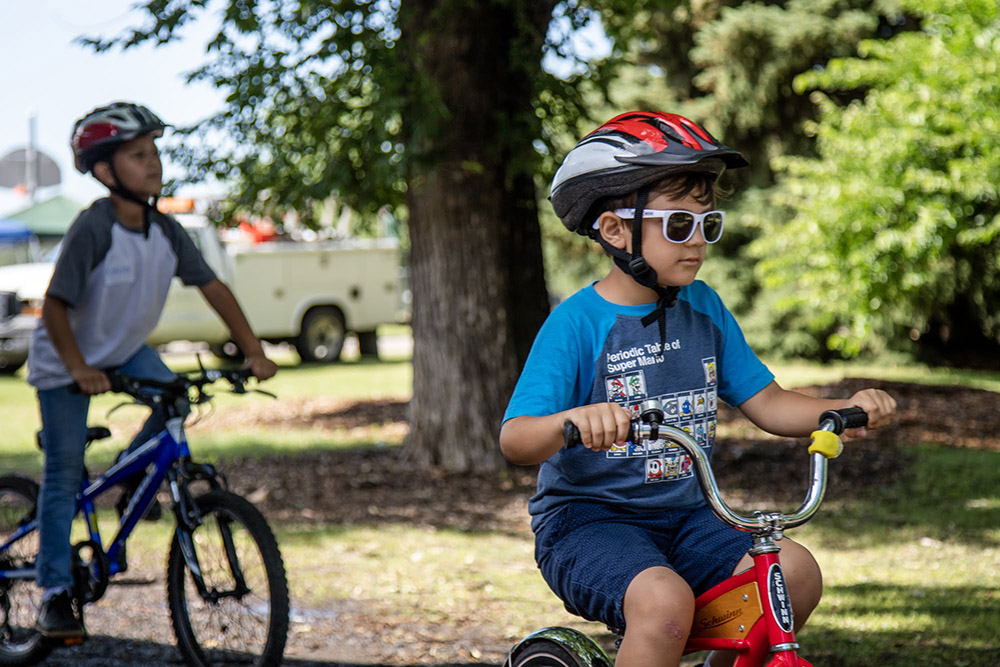
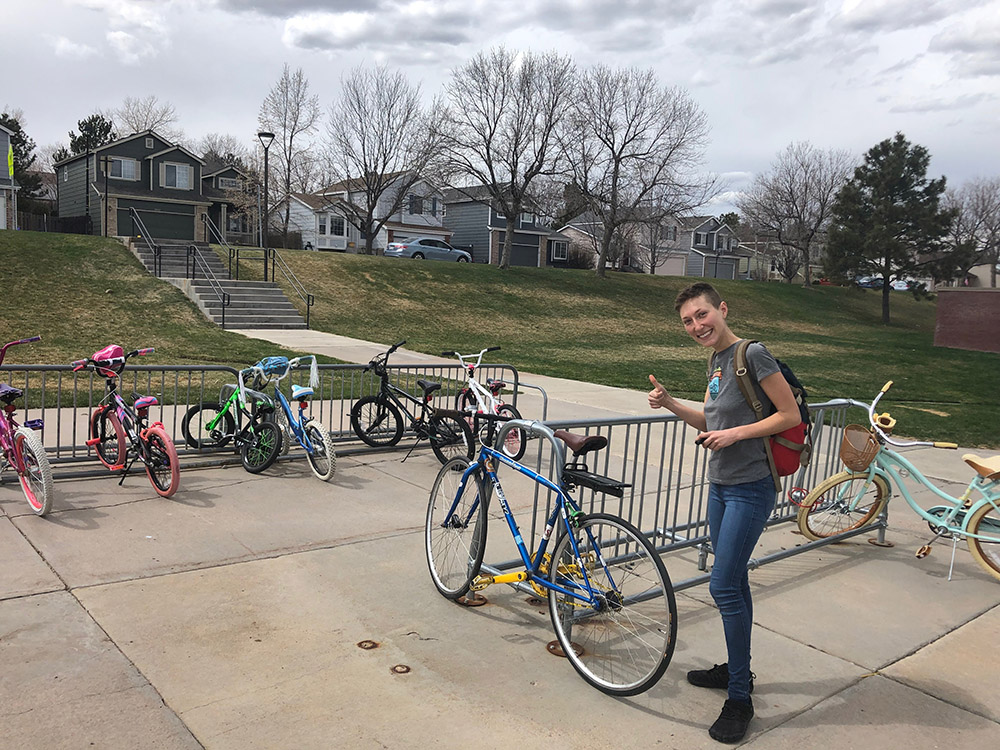
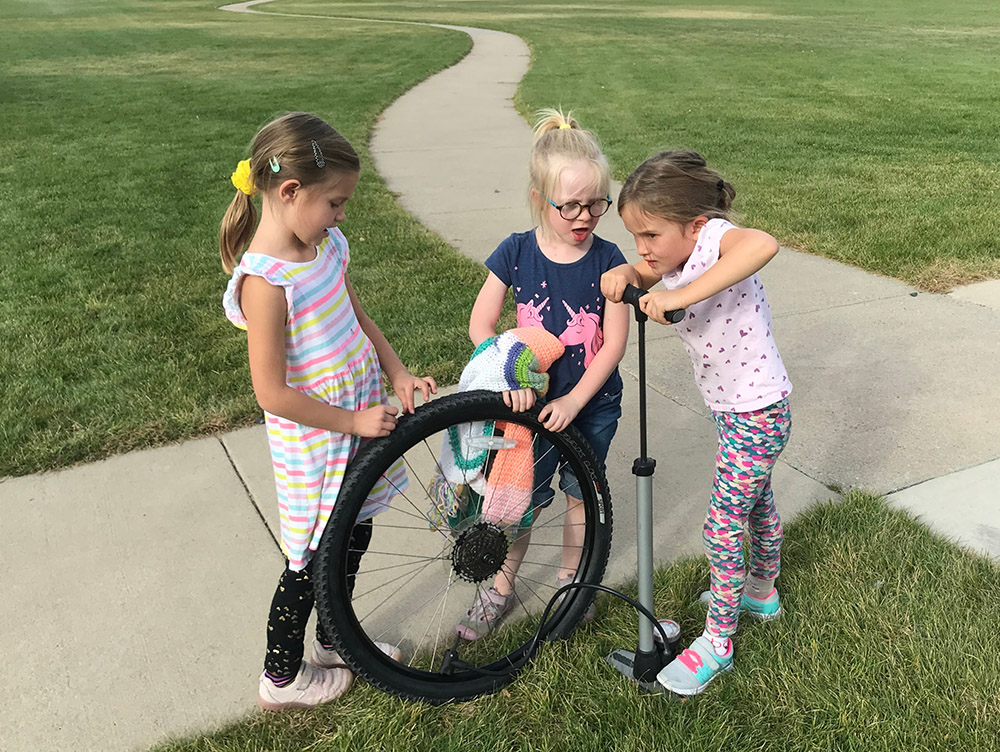
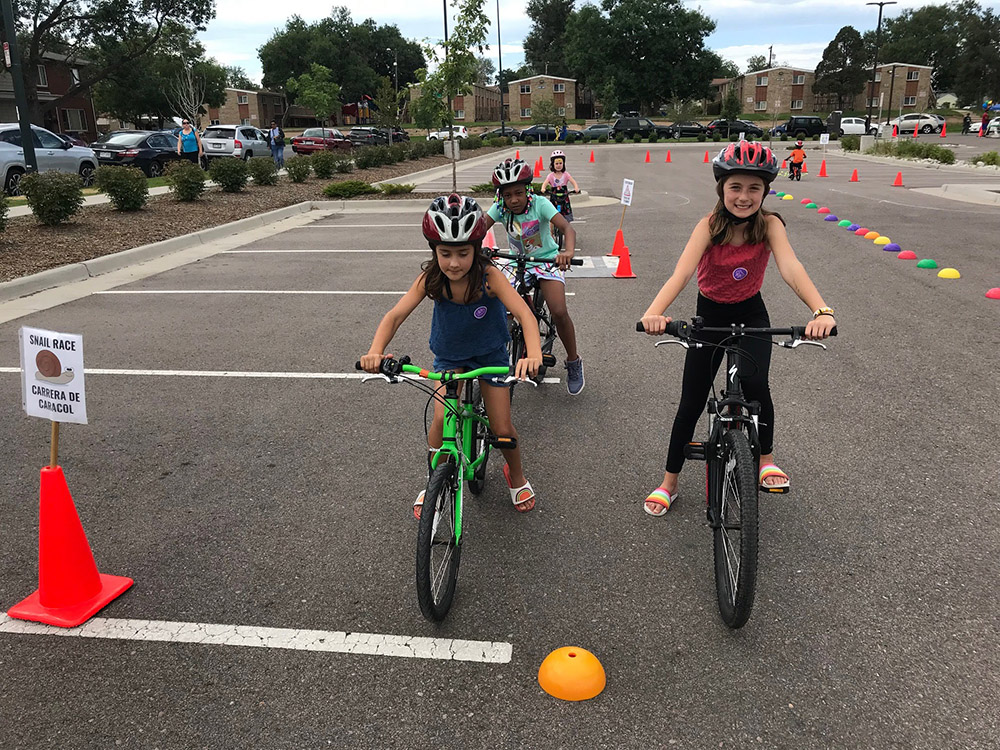
Transitioning to the street
Around 10 years old, most children are developmentally ready to ride in the street after careful modeling and coaching from an adult. If sidewalks are too narrow or you’re ready to begin biking with your child on the street, here we share some laws, skills and conditions you should consider as you start the transition. Remember that children can be less predictable and less visible to drivers, so be very patient and take the time to practice together to prepare your child to model safe, predictable and defensive behaviors on their own. BikeSafe also has some great animated videos that illustrate street-riding skills.
-
- Bikes for coaching: Some bike set-ups will allow you to start coaching your child early before they begin operating their own bike. Check out this article from REI for bike and attachment ideas.
- Reevaluate the route: Your best street route might be different than a route you would take by bike on sidewalks or paths. Reassess the route on your own by bike before your child joins you.
- Bicycles are vehicles: A bike is your child’s first vehicle! Bicycles are vehicles by Colorado state law and bicyclists have the same rights and responsibilities as drivers of motor vehicles. Be sure to model this expectation for your child while also pointing out the differences between people in cars and on bikes. Different sizes, weights, speeds and protection means bicyclists need to be particularly alert and careful around motor vehicles.
- Follow all traffic signs and signals: Bicyclists should follow all rules of the road, including speed limits, traffic lights and stop signs. The only Colorado communities where bicyclists can treat stop signs as yield signs or red lights as stop signs at this time are Aspen, Breckenridge, Dillon, Summit County and Thornton.
- Refuse unlawful courtesies: Follow right of way rules. Entering an intersection before it’s your turn, even with children or when invited to do so by generous drivers, leads to miscommunication and potentially unpredictable and dangerous situations. Put your foot down, give them a smile and encourage others to follow the right of way.
- Positioning and visibility
- Ride with traffic: Like other vehicle operators, bicyclists must ride with the flow of traffic when on the street, even in traditional bikes lanes. An exception is a contraflow bike lane that is well-marked and often separated to safely allow riding against traffic.
- Group positioning: Bicyclists may ride two abreast (side by side) if they’re not impeding the flow of traffic. This can increase their footprint and visibility to other road users. You may choose to ride side by side with your child or, once you’re confident in their awareness and stopping skills, you might stagger yourself behind and to the left of them. In this positioning, your child can set the pace, you can communicate with them from the rear and you can provide a buffer to any drivers approaching from behind.
- Ride to the right: Bicyclists should ride as far to the right of the travel lane as they judge safe. In addition to adjusting for safety, they may leave the right side when preparing for a turn or passing another road user.
- Take the lane: To reinforce the above, bicyclists have the right to ride in the center of the lane, even without designated bike infrastructure present. “Bicyclists may use full lane” signs remind drivers and bicyclists of this. The middle of the lane can often be the safest positioning to be more visible to drivers, avoid obstacles or poor road conditions or to discourage passing in narrow sections of the road.
- Parked cars: Also be sure you and your child are leaving enough room alongside parked cars to avoid doors opening in your path and give space to react to drivers pulling out of their spots.
- Three feet of space: When passing, drivers are required by law to give bicyclists at least three feet of space between the outermost part of their vehicle or any projections and the bicyclist. They are also allowed to cross a double yellow line to provide this three feet minimum.
- Awareness and communication
- Scanning: Scan thoroughly as you ride, particularly before changing lanes or proceeding through an intersection with your child. They can practice the skill of scanning over their shoulder with an activity called “Ride the Line.” Draw a straight line on the ground with chalk or flour and draw a large #1 and #2 on the front and back of a sheet of paper. Ask your child to ride on top of the line, scan over their shoulder and call out which number you’re holding up.
- Intersections: Most crashes between drivers and bicyclists happen at intersections. Reinforce the importance of visibility with your child and give yourself space at intersections to avoid being blocked by other vehicles or shadows, avoid lane-splitting and pass drivers on the right only with plenty of room and caution.
- Hand signals: Adults are required by law to use hand signals before turning if they are comfortable taking a hand off the handlebars. Once your child is confident with their balance and steering, they can start practicing hand signals as they approach a turn. This is particularly important to communicate with drivers. An extended left arm signals a left turn and both an extended right arm or left arm at a right angle can signal a right turn. You can also drop your left arm at a right angle to communicate to others that you are stopping.
- Eye contact: People outside of cars, including children, are often told to make eye contact with drivers. This can be helpful when you have strong vision, are within a close distance, when windows aren’t tinted and when a driver is making an effort to see you, too. If you are in a situation where you aren’t sure whether a driver sees you, exercise defensive riding and wait until they travel across your path first.
We’re excited to see so many families taking advantage of more time together and the beautiful spring weather on their bikes. We hope these ideas will help inspire you to plan a more focused ride with your children during Bike to School Week and continue to practice the route and safe behaviors so your family is ready to commute by bike in the fall!
Have questions? Send me an email at maureen@bicyclecolorado.org!
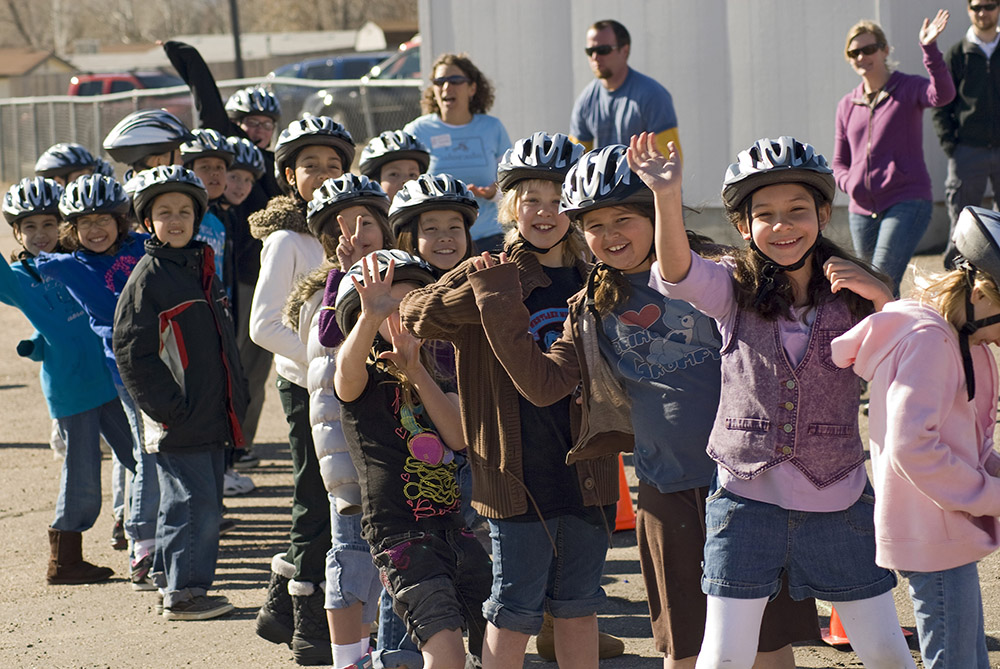
Your membership makes resources like this possible.
Leave A COMMENT
Our twitter feed is unavailable right now.
The Latest News
view all- Mar 22, 2024
- by Bicycle Colorado
Why Colorado Should Pass SB24-065 To Reduce Distracted Driving
- Advocacy Issues,
- Bicycling in Colorado,
- Bike Law,
- Get Involved,
- Laws & Funding
- No Comments





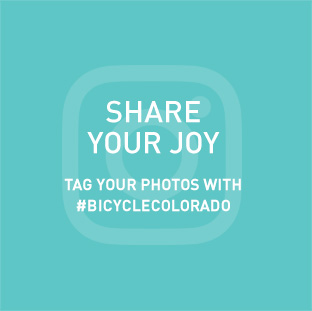
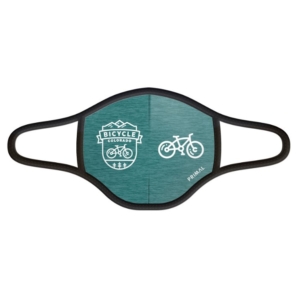
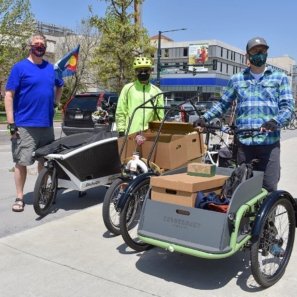
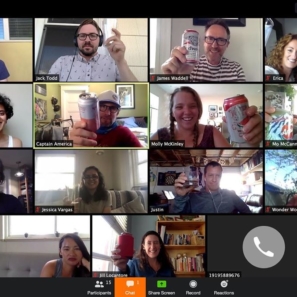
COMMENTS (1)